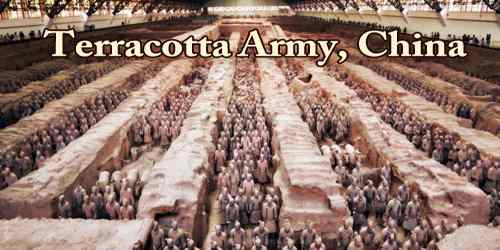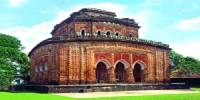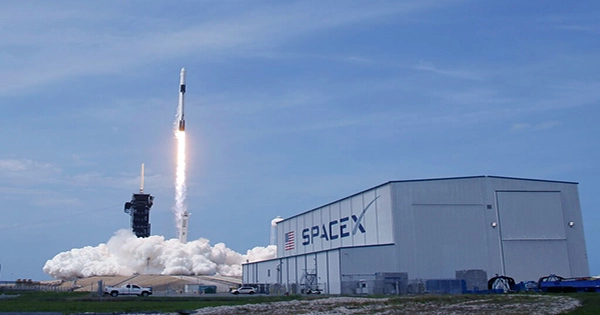The Terracotta Army is a collection of terracotta sculptures depicting the armies of Qin Shi Huang, the first Emperor of China. Thousands upon thousands of life-sized warriors, each with a unique face, stand in rows, where they have stood since they were buried here in the 3rd century BC. It is a form of funerary art buried with the emperor in 210-209 BCE with the purpose of protecting the emperor in his afterlife.
Chinese workers digging a well in 1974 made a startling discovery: thousands of life-size terracotta figures of an army prepared for battle. Now called the Terracotta Army or Terracotta Warriors, the figures are located in three pits near the city of Xi’an in China’s Shaanxi province. After the warriors were discovered, the site became a museum and a UNESCO World Heritage Site in 1987.
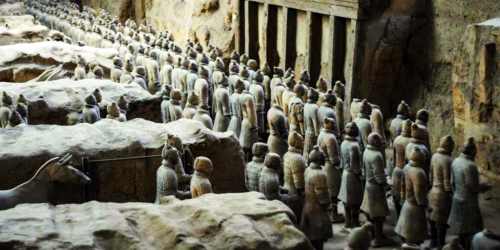
Estimates from 2007 were that the three pits containing the Terracotta Army held more than 8,000 soldiers, 130 chariots with 520 horses, and 150 cavalry horses, the majority of which remained buried in the pits near Qin Shi Huang’s mausoleum. Other terracotta non-military figures were found in other pits, including officials, acrobats, strongmen, and musicians.
According to UNESCO World Heritage Center, archaeologists suspect that the unexcavated tomb could contain an entire replica of the city of Xi’an, which the warriors guard. The three pits (a fourth pit was unfinished) contain an estimated 8,000 life-size terracotta figures of which about 2,000 have been excavated. The figures were created to serve the emperor in the afterlife and include a mix of chariots, cavalry, armored soldiers and archers. There are high-ranking officers (including nine generals found so far) and one of the pits, No. 3, actually served as a command post for the army and contains an honor guard and ornate chariot for the force’s chief commander. All three pits are active archaeological sites and visitors can see excavations taking place.
The construction of the tomb was described by historian Sima Qian (145-90 BCE) in Records of the Grand Historian, the first of China’s 24 dynastic histories, which was written a century after the mausoleum’s completion. Work on the mausoleum began in 246 BCE soon after Emperor Qin (then aged 13) ascended the throne, and the project eventually involved 700,000 workers. Geographer Li Daoyuan, writing six centuries after the first emperor’s death, recorded in Shui Jing Zhu that Mount Li was a favored location due to its auspicious geology, “famed for its jade mines, its northern side was rich in gold, and its southern side rich in beautiful jade; the first emperor, covetous of its fine reputation, therefore chose to be buried there”. Sima Qian wrote that the first emperor was buried with palaces, towers, officials, valuable artifacts and wondrous objects. According to this account, 100 flowing rivers were simulated using mercury, and above them the ceiling was decorated with heavenly bodies below which were the features of the land. Some translations of this passage refer to “models” or “imitations”; however, those words were not used in the original text, which makes no mention of the terracotta army. High levels of mercury were found in the soil of the tomb mound, giving credence to Sima Qian’s account. Later historical accounts suggested that the complex and tomb itself had been looted by Xiang Yu, a contender for the throne after the death of the first emperor. However, there are indications that the tomb itself may not have been plundered.
Over the past 35 years, archaeologists have located some 600 pits, a complex of underground vaults as yet largely unexcavated, across a 22-square-mile area. Some are hard to get to, but three major pits are easily accessible, enclosed inside the four-acre Museum of the Terracotta Army, constructed around the discovery site and opened in 1979.
In one pit, long columns of warriors, reassembled from broken pieces, stand in formation. With their topknots or caps, their tunics or armored vests, their goatees or close-cropped beards, the soldiers exhibit an astonishing individuality. A second pit inside the museum demonstrates how they appeared when they were found: some stand upright, buried to their shoulders in soil, while others lie toppled on their backs, alongside fallen and cracked clay horses. The site ranks with the Great Wall and Beijing’s Forbidden City as one of the premier tourist attractions within China.
The Terracotta Army was discovered on 29th March 1974 by farmers digging a water well approximately 1.5 kilometers (0.93 mi) east of the Qin Emperor’s tomb mound at Mount Li (Lishan), a region riddled with underground springs and watercourses. For centuries, occasional reports mentioned pieces of terracotta figures and fragments of the Qin necropolis roofing tiles, bricks and chunks of masonry. This discovery prompted Chinese archaeologists, including Zhao Kangmin, to investigate, revealing the largest pottery figurine group ever found. A museum complex has since been constructed over the area, the largest pit being enclosed by a roofed structure.
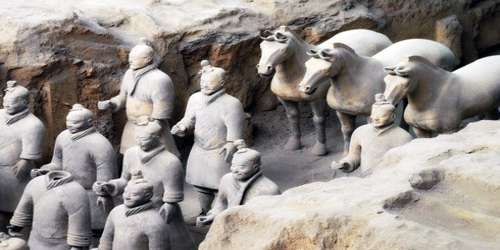
The details of the warriors are so intricate and individualized that it has been hypothesized that they were based on real soldiers who served in the emperor’s army. Each warrior has uniquely styled hair and features; some have topknots while others have goatees; some have caps and loose tunics while others have armored vests and braided hair. They have different builds, expressions, and postures. Another key feature is that the warriors were decorated in bright colors, which contributed to the individuation. New conservation techniques, performed on recently excavated figures, allow some of these patterns to be discerned. Every warrior contains a stamp of the name of the foreman in charge of his creation so that mistakes could be tracked, according to the Field Museum.
Throughout recorded Chinese history, the first emperor’s Ebang Palace its site on the Wei River, south of ancient Xianyang, was not investigated until 2003 was synonymous with ostentation. The structure was said to have been the most lavish dwelling ever constructed, with an upper-floor gallery that could seat 10,000 and a network of covered walkways that led to distant mountains to the south.
“All Chinese people who can read, including middle-school students, believed that the Qin dynasty collapsed because it put so much money into the Ebang Palace,” says archaeologist Duan. “According to excavation work from 2003, we found it was actually never built only the base. Above it was nothing.” Duan says that if the palace had been erected and demolished, as historians thought, there would be potsherds and telltale changes in soil color. “But tests found nothing,” says Duan. “It is so famous a symbol of Chinese culture for so long a time, showing how cruel and greedy the first emperor was and archaeologists found it was a lie.” Duan also doubts accounts of Qin Shi Huangdi’s expedition for life-prolonging herbs. His version is more prosaic: “I believe that the first emperor did not want to die. When he was sick, he sent people to find special medicines.”
The tomb appears to be a hermetically sealed space roughly the size of a football pitch (c. 100 × 75 m). The tomb remains unopened, possibly due to concerns over the preservation of its artifacts. For example, after the excavation of the Terracotta Army, the painted surface present on some terracotta figures began to flake and fade. The lacquer covering the paint can curl in fifteen seconds once exposed to Xi’an’s dry air and can flake off in just four minutes.
Scientists have used remote sensing, core sampling, and radar to discover that the tomb complex is almost 38 square miles (98 square kilometers). They suspect it contains a replica of the city of Xi’an, as well as its rivers and streams. In addition to clay inhabitants warriors, acrobats, etc. thousands of real people were also buried with their emperor. Many were craftsmen and convicts who died building the mausoleum. Hundreds of concubines were also buried there, possibly to accompany their emperor to the afterlife, or possibly as part of elaborate court intrigue, according to National Geographic.
An exhibition entitled “China’s First Emperor and the Terracotta Warriors” is at the World Museum in Liverpool from 9 February 2018 to 28 October 2018. This is the first time in more than 10 years that the warriors have traveled to the UK.
Information Sources:
